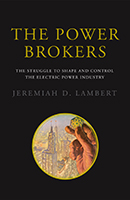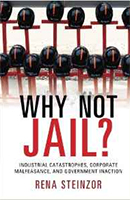 Verdict: It’s a Keeper
Verdict: It’s a Keeper
The Power Brokers: The Struggle to Shape and Control the Electric Power Industry
By Jeremiah D. Lambert (Cambridge, MA: The MIT Press, 2015). 400 pgs. $29.95. Order, mitpress-orders@mit.edu.
Reviewed by Marc J. Adesso
The Power Brokers tells the story of the rise and development of the modern, post-Edison electrical power industry through a series of biographical sketches, each of which form an independent chapter of the book. The theme that binds the seven sketches is the tension between, and ultimate integration of, the forces of governmental regulation and business’s competitive necessity for profit in the electrical power industry.
The book begins with Samuel Insull, a Dickensian character who started life in soot-covered Victorian England, spent time working shoulder-to-shoulder with Thomas Edison, and became (arguably) the most influential electric power baron of his time. Like many Dickens stories, Lambert’s recounting of Insull’s life ends in tragedy, with a regulatory crackdown on Insull’s pyramid scheme-like operation that resulted in criminal prosecution.
Want to Review a Book?
Please request a book and writing guidelines from Wisconsin Lawyer managing editor Karlé Lester, at klester@wisbar.org or (608) 250-6127. Reviewers may keep the book reviewed. Reviews of about 500 words are due within 45 days of receiving the book. Reviews are published, space permitting, in the order received and may be edited for length and clarity.
Lambert then shifts focus to two governmental servants who tangled with regulatory bodies in a more internal capacity. First, he discusses David Lilienthal and his role in shaping the Tennessee Valley Authority, one of the nation’s few public electric power producers. Lambert then uses Don Hodel’s biography to tell the story of failed attempts to build nuclear power plants in the United States, in the face of the 1970s energy crises (climaxing with the 1973 oil shortage). While not as compelling as the drama of Samuel Insull’s life, these portraits of iron-willed governmental employees show how dedication and good intentions in the service of the public sometimes succeed or fail because of political factors outside the electric power industry itself.
Next, the book moves its focus to two academics. First is Paul Joskow, the MIT economics professor whose research papers on the reorganization of energy markets eventually became the blueprint for regulatory reform of U.S. energy markets. Second is Amory Lovins, a pioneer in the area of sustainable power production through community-based electricity generation. These sketches lack the drama of the book’s initial chapters. Because policy and theory in the electric power industry are not areas of interest for me, the chapters on Joskow and Lovins left me yearning for the more exciting, take-no-prisoners stories told earlier in the book.
Such yearning did not go unsatisfied. The chapters about Ken Lay and Jim Rogers regained the dramatic pace of the book’s earlier chapters. After describing the infamous, disastrous, and ultimately criminal collapse of Ken Lay’s Enron, Lambert concludes with Jim Rogers, chief executive of Duke Energy. Rogers’ approach seems to suggest a better path for executives in the modern electric power industry, snaking a tight path between energy producers and governmental regulators to simultaneously keep his company ahead of the curve of competitors and wring profit out of changes in the law.
Overall, I found Lambert’s book to be an engaging read, and I recommend it to anyone interested in learning about the history and development of the electric power industry.
Marc J. Adesso, Marquette 2010, operates Adesso Law Group LLP, Milwaukee.
 Verdict: It’s a Keeper
Verdict: It’s a Keeper
Why Not Jail? Industrial Catastrophes, Corporate Malfeasance, and Government Inaction
By Rena Steinzor (New York, NY: Cambridge Univ. Press, 2015). 283 pgs. $32.99. Order, www.cambridge.org.
Reviewed by Mel S. Johnson
Rena Steinzor, professor of law at the University of Maryland and past president of the Center for Progressive Reform, clearly reveals the theme of her book in its title. To illustrate that theme, she reviews fatal health and safety catastrophes caused by corporations, including oil-well blowouts, salmonella outbreaks, explosions in coal mines and oil refineries, and meningitis resulting from unsanitary pharmaceuticals.
Steinzor argues that customary legal approaches to corporate malfeasance, emphasizing regulatory enforcement, deferred prosecution, and financial penalties, have failed to deter such behavior. She recommends more aggressive criminal prosecution and sentencing, focused on individuals rather than organizations.
Historically, governmental regulation has been quite successful in controlling corporate activity on health and safety issues. However, Steinzor describes how persistent opposition from regulated industries and their political allies has crippled regulatory agencies through inadequate funding, outmoded statutory schemes, and politicization of the rule-making process. Accordingly, the legal system can no longer rely on administrative enforcement as the main bulwark against corporate misconduct.
Under commonly used deferred-prosecution agreements, offending corporations are not prosecuted if they comply with certain conditions and procedures meant to prevent a return of the misconduct. Steinzor argues that such agreements fail to deter corporate crime because of their lack of judicial oversight and of prosecutorial commitment to spend the time and effort necessary to monitor the corporation to ensure compliance.
Steinzor advocates going beyond specific intent to aggressively rely on knowledge and recklessness to criminalize systemic and prolonged corporate acts and omissions that magnify risk to workers and consumers. She laments that the present focus on prosecuting organizations, not individuals, results in fines that, although large, can be treated as tolerable costs of doing business, particularly for major corporations. Steinzor advocates prosecution of officials as high as possible within their organizations. She believes that officials facing personal sanctions, especially jail, are much more likely to promulgate effective policies to deter corporate misconduct.
Many of the author’s descriptions of legal standards and procedures are too simple to be helpful to lawyers, at least criminal lawyers. Her description of the applicable criminal law is based on the Model Penal Code, which is not the basis of federal law or of most states’ criminal law. The book relies heavily on academic studies that require more attention than most readers are probably willing to give. The author repeatedly refers to certain points in passing without always clearly explaining them in a unified section.
These small criticisms aside, this is a significant book raising important issues and suggesting solutions that deserve serious consideration. Its point of view reflects a quotation from sociologist Dan Kahan: “What a community chooses to punish and how severely tells us what (or whom) it values and how much.”
Mel Johnson, Washington Univ. 1975, has been an Assistant U.S. Attorney in Milwaukee for 35 years, after five years as an Assistant State Public Defender.
